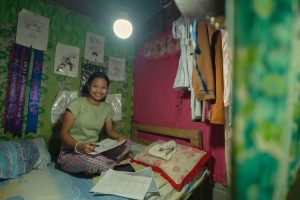
For most of her life, junior high school student Res-Ann Maravillas Baticura has spent each day adjusting to the challenges of studying in remote Barangay Lumiad, Paquibato District, in Davao City.
One such challenge was the lack of electricity in her school. In these days of record heat and remote classes, it has become a more pressing matter for over 140 students in Lumiad National High School. They have had to either endure holding classes in the dark or suffer having no face to face classes at all.
To add to that, during the pandemic, the students had to take home their schoolwork and be at the mercy of social distancing.
At the height of El Nino, the school would end classes altogether and ask the students to go home instead. Res-Ann shares, “Lisod magstudy sa una sa school kay igang kaayo. Dili namo ma-on ang electric fan kay walay kuryente.” (It was really hard to study in our school when we didn’t have electricity, and we couldn’t even turn on the electric fan. It was very hot.)
In the past, students and their families would each find a way to charge their mobile phones and other gadgets to use for school at a few neighbors’ houses, which were already connected to the grid.
Even if the school system shifted to modular (or take home) learning, it was difficult to adjust. “Mas makatuon mi kung makita namo among mga teachers ug ang usag-usa (We learn better if we can see our teachers and one another),” Res-Ann said. However, at certain times, the school would be darkened without power.
When face-to-face classes resumed, it was no better as school administrators would often be forced to send their students home later in the day. It was hot without electric fans, students could not print reports, and classes could not enjoy watching educational videos on screen because the school was not yet connected to the electrical grid. Some students have decided to drop out of class, Res-Ann said, as going to school was not as conducive as it should be.
In 2023, Res-Ann joined a group of youth leaders from her district to seek assistance for their various concerns from the local government at the Children’s Congress. There, Res-Ann was an influential voice who told local officials their community’s concern: They needed power in their upland barangay, where only four out of thirteen sitios have been energized since the early 90s.
Meanwhile, the wheels have started to turn for the community with the cooperation among local officials and Davao Light and Power Co., Inc. (Davao Light). Davao Light is an AboitizPower subsidiary and the country’s third largest private electric distribution utility. In the same year, Davao Light brought power to nine sitios of Barangay Lumiad through the Sitio Electrification Program (SEP).
The SEP is a national government project, which connects far-flung areas like Brgy. Lumiad into electrical grids of distribution utilities such as Davao Light. It is one of the government’s priority programs for economic development and poverty reduction by aiming for 100% electrification of the Philippines. The program aims to energize 399 sitios in Mindanao, along those in Luzon and in Visayas.
“Mura og nadungog ang among mga tingog (It seemed our voices were heard),” Res-Ann said. “Dako kaayo ang deperensiya kung mag-study gamit ang lampara kaysa mag-study gamit ang bombilya. Kung bombilya, muhayag ang tibuok kwarto ug mas safety kaysa mugamit og lampara (There’s a huge difference between studying using a lamp and studying using a lightbulb. When you use lightbulbs, the entire room lights up, and it’s safer than using a gas lamp.”
When the Davao Light connected the school into the city’s grid, studying became conducive for students like Res-Ann.
With the school now energized, students could now watch educational shows, using televisions connected to the local Wi-Fi vending machine, classrooms were now better lit because of the functioning fluorescent lamps, and the electric fans inside the classrooms and offices gave everyone a fighting chance against record-breaking heat.
They could now print documents, too, which was unthinkable during the community’s darker ages. “Mangutana ra mi sa among teachers kung pwede mi makigamit sa printer sa ilang office para makiprint of official reports (We just ask our teachers if we could use their office’s printer to print official reports),” Res-Ann said. “Nalipay gyud ko na mabuhat na ni namo. Salamat sa Davao Light (I’m very happy that we can finally do this, thanks to Davao Light.)”
With electricity in their school, Res-Ann and fellow students now need to tackle other concerns, particularly energy-saving practices among their student body. As the president of their student government, that has become one of her top agenda.
With power now more available and nearby, the students of Lumiad’s National High School may be well on their way to a brighter future.
